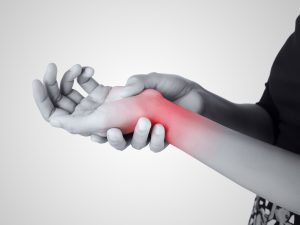What is De Quervain’s Tenosynovitis?
De Quervain’s Tenosynovitis is an inflammatory condition affecting the tendons that control the thumb, at the wrist. These tendons are called the Abductor Pollicis Longus (APL) and the Extensor Pollicis Brevis (EPB). These two tendons travel through a tunnel of connective tissue (called tenosynovium) on the inside edge of the wrist, and they glide through that tunnel as you move your thumb. Tenosynovitis refers to the inflammation of this tenosynovium.
This condition occurs in females up to six times more frequently than males, between the ages 30-50 years, and presents as pain and sometimes swelling in the thumb and wrist areas.
What causes it?
Causative factors include activities that involve repetitive or sustained tension on the tendons, especially if the activity has the wrist in an awkward position. These repetitive or sustained activities may include:
- Grasping
- Pinching
- Squeezing
- Wringing
- Writing
- Typing
Risk factors that can increase the likelihood of this condition developing include:
- Repetitive microtrauma
- Increased volume states i.e. pregnancy
- Scar tissue from previous wrist injury
- Anatomical variations at the wrist
- Inflammatory disease
- Arthritis
- Ganglion cyst
Common symptoms of De Quervain’s Tenosynovitis:
Primary symptoms are pain with or without swelling at the base of the thumb that may increase in intensity and with movement over time. The pain may appear either gradually or suddenly and may radiate up the forearm. Other symptoms may also include:
- Numbness
- Development of a cyst
- A catching or snapping sensation may be felt as the tendons try to glide through the tunnel with thumb/hand movement
- Difficulty or inability to grip objects
How long does it take to recover?
Resolution of symptoms may take between 6-12 weeks and some may benefit from the use of a splint for up to 4 weeks to immobilize the wrist and thumb. Once healed, full grip strength and normal movement should return with no painful symptoms. As with most musculoskeletal conditions, compliance with rehabilitation will expedite healing.
Treatment options.
The prime objective when treating De Quervain’s Tenosynovitis is to reduce irritation and aggravation of the tendons to allow them to heal. Patients presenting with mild to moderate complaints of pain can be treated through conservative means such as:
- Rest and avoidance of aggravating activities
- Splinting
- Western acupuncture or dry needling
- Non-steroidal anti-inflammatories (prescribed by pharmacist or GP)
- Steroidal injection – may help to reduce swelling and pain (performed by specialist)
Should conservative approaches not provide effective relief, surgical interventions may become a viable option to increase the room for the affected tendons to travel through the wrist. Regardless of which intervention is needed, normal use of the hand can usually be resumed once pain has reduced and strength has returned to the hand.
If you’ve been suffering from any of the symptoms of De Quervain’s Tenosynovitis, please give us a call and we’ll be able to provide the correct treatment option for you.












